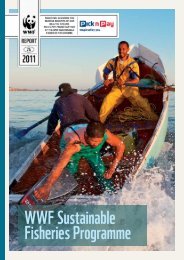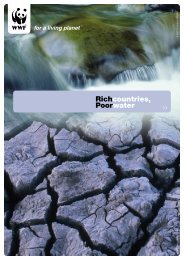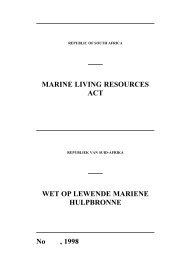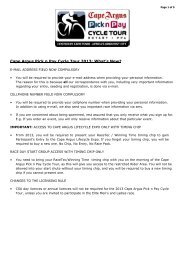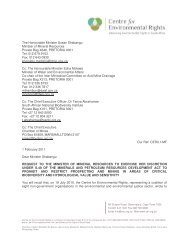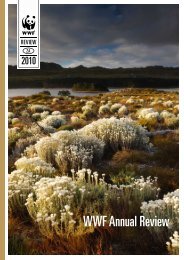State of Management of South Africaââ¬â¢s ... - WWF South Africa
State of Management of South Africaââ¬â¢s ... - WWF South Africa
State of Management of South Africaââ¬â¢s ... - WWF South Africa
- No tags were found...
You also want an ePaper? Increase the reach of your titles
YUMPU automatically turns print PDFs into web optimized ePapers that Google loves.
STATE OF MANAGEMENT OF SOUTH AFRICA’S MARINE PROTECTED AREAS6.3.2 Legal and organisational frameworkThe De Hoop MPA was initially proclaimed in 1985 and then later re-proclaimed under theMLRA in 2000. The adjacent De Hoop Nature Reserve, a World Heritage Site, was listedunder the World Heritage Convention Act 1999 in July 2004. There are no regulations orobjectives in the legislation specific to De Hoop.6.3.3 MPA designMPA DESIGN (67%)The length <strong>of</strong> the shoreline <strong>of</strong> the MPA is 46km and it extends 3 nautical miles <strong>of</strong>fshore. Thetotal area <strong>of</strong> the MPA is 253km 2 . The entire area is a no take zone and it was indicated thatthere was no need to zone recreational activities. The size and shape <strong>of</strong> the MPA Isadequate and it could buffer the interior from edge effects. The Breede River mouth wasexcluded from the MPA. This estuary is an important fish nursery area and impactsecological processes within the MPA.6.3.4 MPA <strong>Management</strong> PlanEXISTENCE OF PLAN, OBJECTIVES AND REGULATIONS (67%)A management plan for the MPA was prepared in 2006. The plan lists the broad objectivesfor MPAs under the MLRA and the generic biophysical, social and governance objectivesprovided by CapeNature that are applicable to the MPA. The management plan is designedto aid in the achievement <strong>of</strong> these objectives. Allowable and restricted activities were dealtwith clearly in the plan.PLAN IMPLEMENTATION AND ADEQUACY (50%)The plan is a general guiding document that sets out priorities for the MPA. There were nospecific management actions prescribed in the plan and it did not facilitate resourceallocation adequately. In the absence <strong>of</strong> a permanent manager to use the plan as a guidingtool for formulating work plans and operational plans, there were few aspects <strong>of</strong> this plan thatwere useful for day to day management. The plan is in need <strong>of</strong> revision and requiresimprovement with regard to defining long-term visions and adaptive management.SOCIO-ECONOMIC CONSIDERATIONS (25%)There was insufficient engagement with local stakeholders during the planning process.Local communities and cultural aspects were given some consideration in the managementplan but the local stakeholders did not have an adequate role and input in planning.Pg 80






